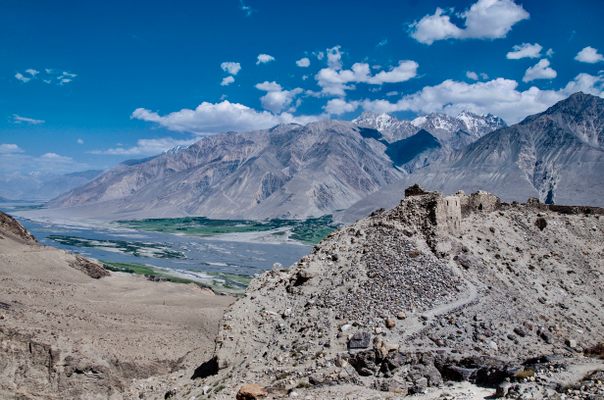About
Located between the modern-day border between Tajikistan and Afghanistan, at elevations ranging from 9,964 feet (3,037 meters) in Ishkashim to 16,152 feet (4,923 meters) at the Wakhjir Pass, the remote and barren Wakhan Valley was once a thriving corridor along the Silk Road. Ruins of caravanserais, stupas, forts, towers, and palaces littering the whole valley testify to a glorious past.
Traders from near and far have been plying the Silk Road for millennia. This flurry of activities did not escape the keen eye of the Kushan Empire, which realized that traders needed safe passage to transport their goods, which they could guarantee in exchange for levies. A large number of fortresses were built with the dual purpose of protecting traders from raiders and protecting the empire from neighboring peoples.
Yamchun Fortress is the best preserved of all these constructions. The fortress is not in great shape, but given that it sits on top of a highly eroded hill in an area prone to earthquakes and landslides, it is a marvel that it is still standing.
Originally built in 300 BC (or 100 BC according to some sources), Yamchun overlooks large swathes of the Wakhan Valley, and large sections of the Hindu Kush mountains in the northernmost Afghan territories. How much of the original fortress is visible today is debatable, as the ancient structure was expanded between the 10th and 12th centuries.
The triangular shape of the fortress follows approximately the shape of the hilltop. Two layers of fortified walls delineate its perimeter. Round towers with narrow openings look down toward the valley. Looking at the towers still standing, it is clear that they were built in stages, judging from the different coloring of the stones and bonding material.
It is suspected that within the Yamchum Fortress there was a Zoroastrian temple of eternal fire. Considering it was the predominant religion of the time, this would be hardly surprising, but there is no unanimous consensus as to whether there actually was a temple in the fortress.
Related Tags
Know Before You Go
Public transport to Yamchum village is patchy to say the least. Only a handful of shared taxis come this far, but it is common to flag down any passing vehicle and contribute to the cost of the ride. From Yamchun village to the fortress is another 8 km of gentle uphill switchbacks or 4 km of steep climbing along trails. Having your own vehicle is by far the best option.
Central Asia Road Trip: Backroads & Bazaars
A 2-Week, 4-Country Odyssey.
Book NowPublished
August 8, 2018








































